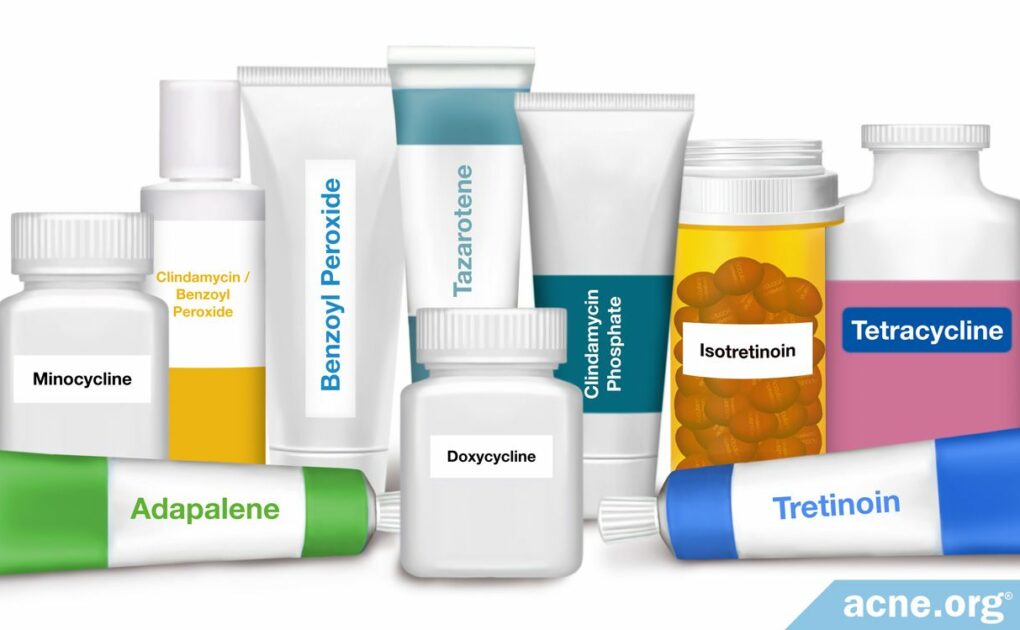Retinoids, Benzoyl Peroxide, and Antibiotics Top the List

The Essential Info
The four most frequently prescribed acne medications are:
- Tretinoin – topical retinoid
- Isotretinoin* – oral retinoid
- Clindamycin/Benzoyl Peroxide combination** – topical antibiotic + benzoyl peroxide
- Minocycline – oral antibiotic
*Isotretinoin comes with severe and potentially lifelong side effects, and is only approved for use in people with severe and scarring acne that does not respond to other treatments. However, because of its effectiveness, doctors sometimes controversially prescribe it for milder acne as well.
**Over the years, combination treatment has become more common, and prescribing topical antibiotics alone has become less common.
Be Your Own Advocate: To avoid a medication merry-go-round, do your own research in order to understand your options. Don’t simply accept any prescription your doctor advises. Arm yourself with knowledge on the available options, and ask questions. And make sure you are speaking to a dermatologist who is an expert in acne.

The Science
Several studies have looked into the question of which prescriptions are most common for acne. The most recent data comes from a 2014 study that included data from approximately 31 million patient-visits between 2005 and 2010. Here are the top 10 most commonly prescribed medications:
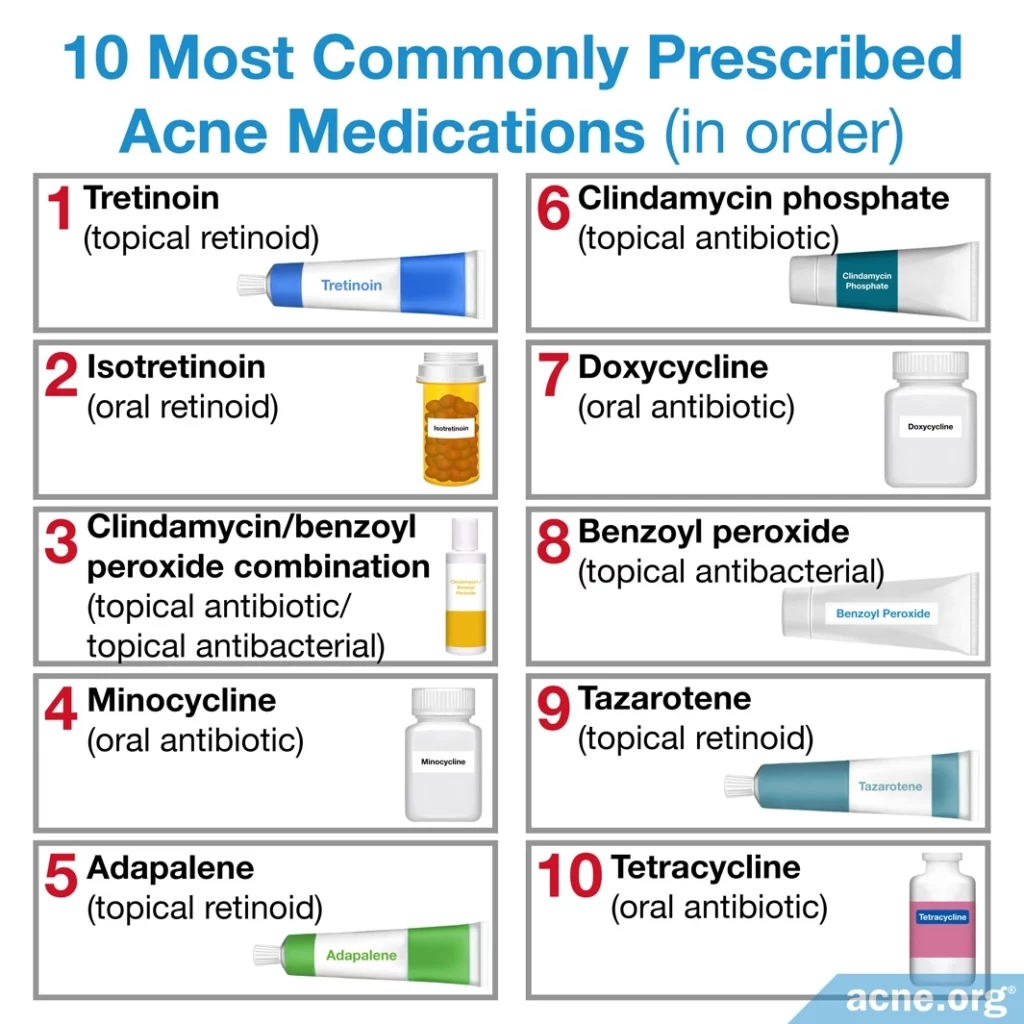
In this article, we will discuss in more detail the top four most commonly prescribed medications, and then consider changes that have occurred over the years in prescribing practices.
The Four Most Commonly Prescribed Acne Medications
#1: Tretinoin
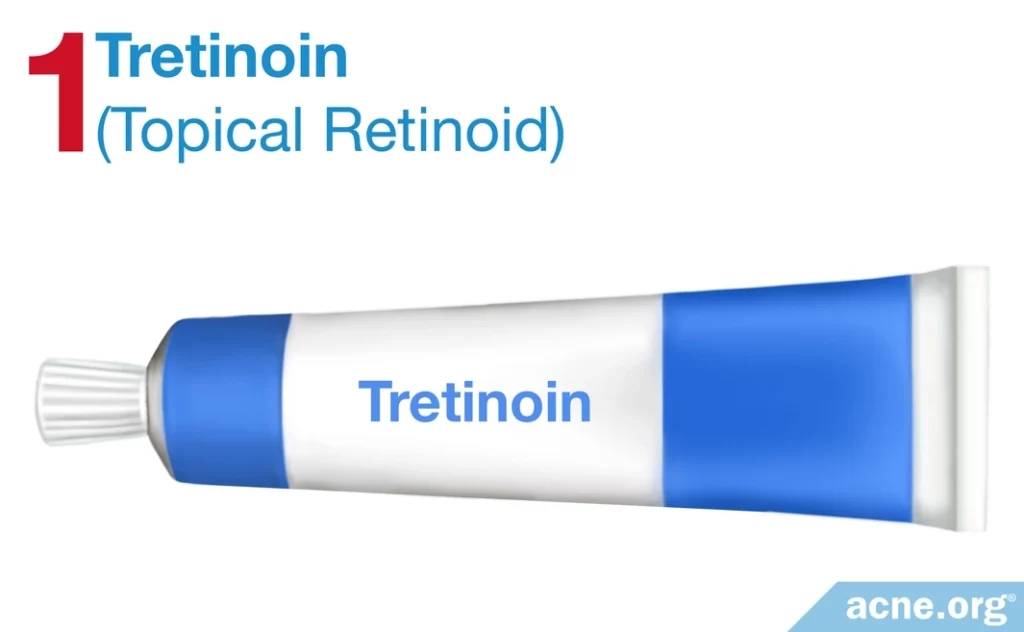
Despite providing only moderate benefit to acne, tretinoin is the single most frequently prescribed acne medication. Various treatment guidelines, such as those recommended by the American Academy of Dermatology, consider topical (applied to the skin) retinoids, such as tretinoin, to be the preferred treatment for acne, except in severe cases. Many guidelines continue to recommend topical retinoids as the first choice of treatment for mild-to-moderate acne. However, it should be noted that since retinoids like tretinoin only produce partial clearing of acne, they are almost always prescribed alongside other treatments.
Tretinoin has been one of the primary acne treatments for over 40 years, largely because of its ability to:
- Help skin cells shed, thus keeping the skin turning over properly and preventing clogged pores
- Treat mild acne lesions as well as papules and pustules, which are inflamed “pimples” or “zits,” when used in combination with other medications
- Reduce skin inflammation
- Prevent acne-induced scarring
- Prevent disease progression – in other words, preventing acne from getting worse2
The following research from the Journal of the American Academy of Dermatology, American Journal of Clinical Dermatology, and Journal of Dermatological Treatment speak about how retinoids help unclog pores, and can help clear acne when used alongside other medications.
Expand to read details of research

The American Academy of Dermatology’s guidelines of 2016, published in the Journal of the American Academy of Dermatology, states, “Retinoids are the core of topical therapy for acne because they [open clogged pores], resolve the precursor microcomedone lesion, and are antiinflammatory. These agents enhance any topical acne regimen and allow for maintenance of clearance after discontinuation of oral therapy. Retinoids are ideal for comedonal acne and, when used in combination with other agents, for all acne variants.”1
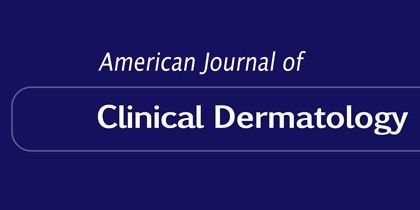
A 2003 article in the American Journal of Clinical Dermatology notes, “Preclinical data suggest that topical retinoids and retinoid analogs may also have direct anti-inflammatory effects. A wealth of clinical data confirms that topical retinoids and retinoid analogs significantly reduce inflammatory lesions.”2

Despite the fact that dermatologists consider topical retinoids to be the preferred therapy for acne, and the fact that guidelines have recommended since 2003 that all patients who have mild to moderate acne be treated with a topical retinoid, a 2013 study in the Journal of Dermatological Treatment found that doctors prescribed topical retinoids only to 40% of patients. This study found also that doctors were more likely to prescribe a topical retinoid to young patients and also to female patients, regardless of their age. The authors noted, “Based on the strong clinical evidence, acne management guidelines have recommended since 2003 that almost all acne patients should be treated with a topical retinoid except for those with the most severe cases. Nevertheless, according to our findings from the most recent data available, the frequency of topical retinoid use for acne vulgaris remains low.”3
#2: Isotretinoin
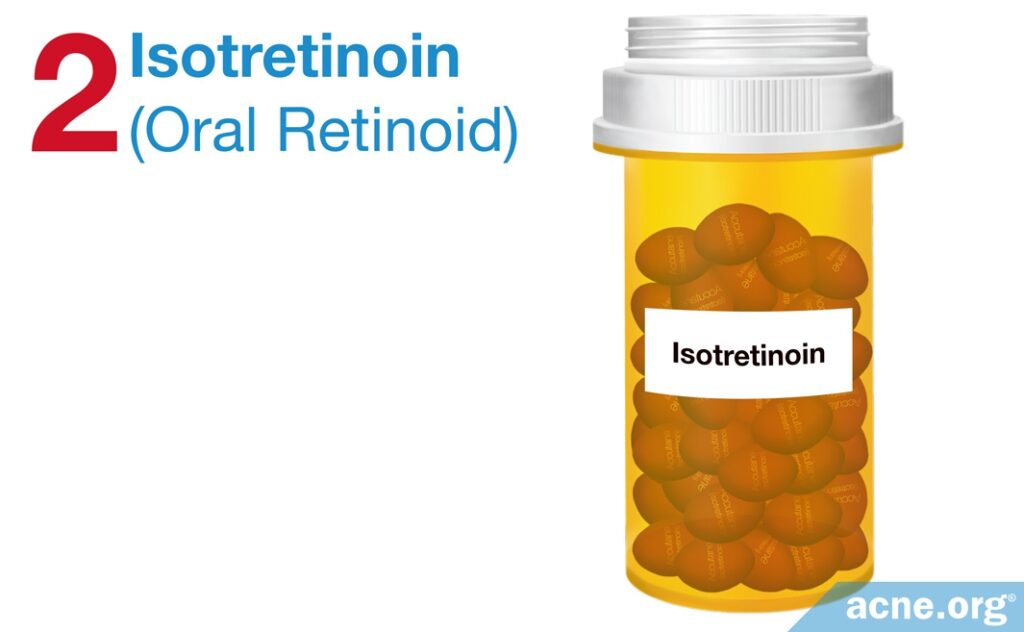
Isotretinoin, often known by its brand name Accutane®, is the second-most prescribed acne medication. It is a highly effective oral medication which typically is only approved for the most severe cases of acne. Patients take isotretinoin usually for 15 – 20 weeks, and in that time it successfully shrinks skin oil glands, usually permanently. Because of its long-lasting effects, it can offer long-term relief from acne symptoms in the majority of people who take an adequate dosage. In 14.6 to 52% of people, acne returns to some degree after isotretinoin treatment, but often the acne that comes back is less severe than before treatment.
Because of isotretinoin’s effectiveness, doctors increasingly prescribe it for mild-to-moderate acne as well. This practice is highly controversial because isotretinoin is such a powerful medication that it can cause severe birth defects if a patient takes it when pregnant. It also can cause severe, sometimes long-term, side effects. The FDA (U.S. Food and Drug Administration) recommends isotretinoin only for severe nodular acne.
#3: Clindamycin/Benzoyl Peroxide combination
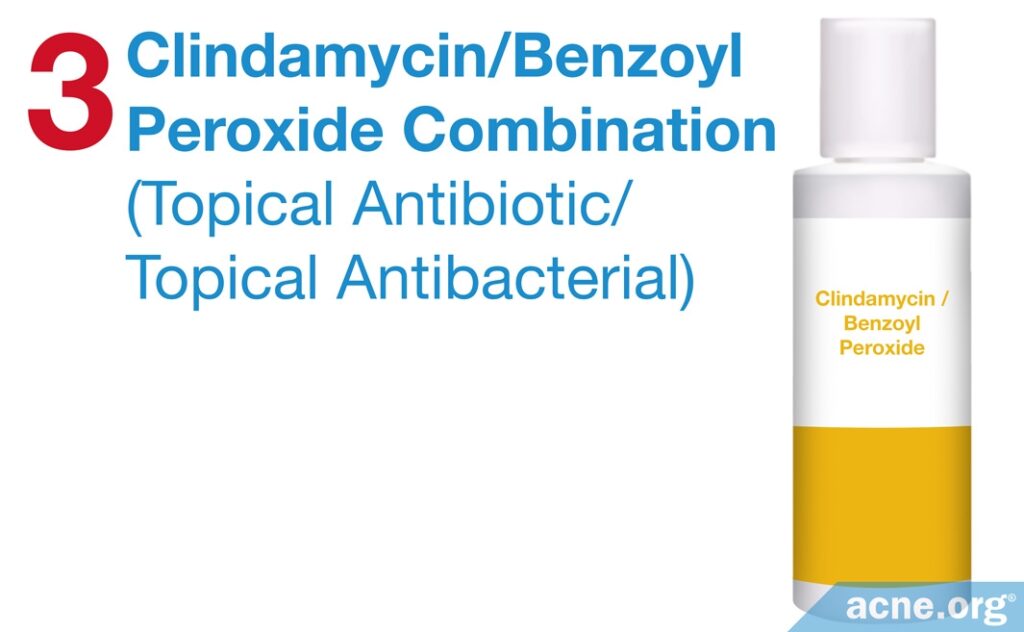
The combination of clindamycin and benzoyl peroxide, either as a single product that combines both substances (one popular brand name is BenzaClin®) or as two separate products, is the third-most frequently prescribed acne medication. Previously it had ranked lower on the list of medications prescribed for acne. However, doctors prescribe it more frequently now because recent evidence has shown that combination treatment is more effective than either clindamycin or benzoyl peroxide alone.
Clindamycin, also known as clindamycin phosphate, is an antibiotic and is prescribed in its topical form to reduce skin inflammation. However, current guidelines recommend that topical antibiotics not be used alone and that they be used only for a maximum of three months. The reason for these restrictions is that bacteria can become resistant to antibiotics over time. It should also be noted that clindamycin does not work for everyone.
Benzoyl peroxide is a mainstay of acne treatment and works by quickly and almost completely killing acne bacteria as well as drying the skin and shedding skin cells, thus keeping pores from becoming clogged. It is available by prescription as well as over-the-counter, in up to 10% strength. One benefit of benzoyl peroxide is that bacteria cannot become resistant to it.

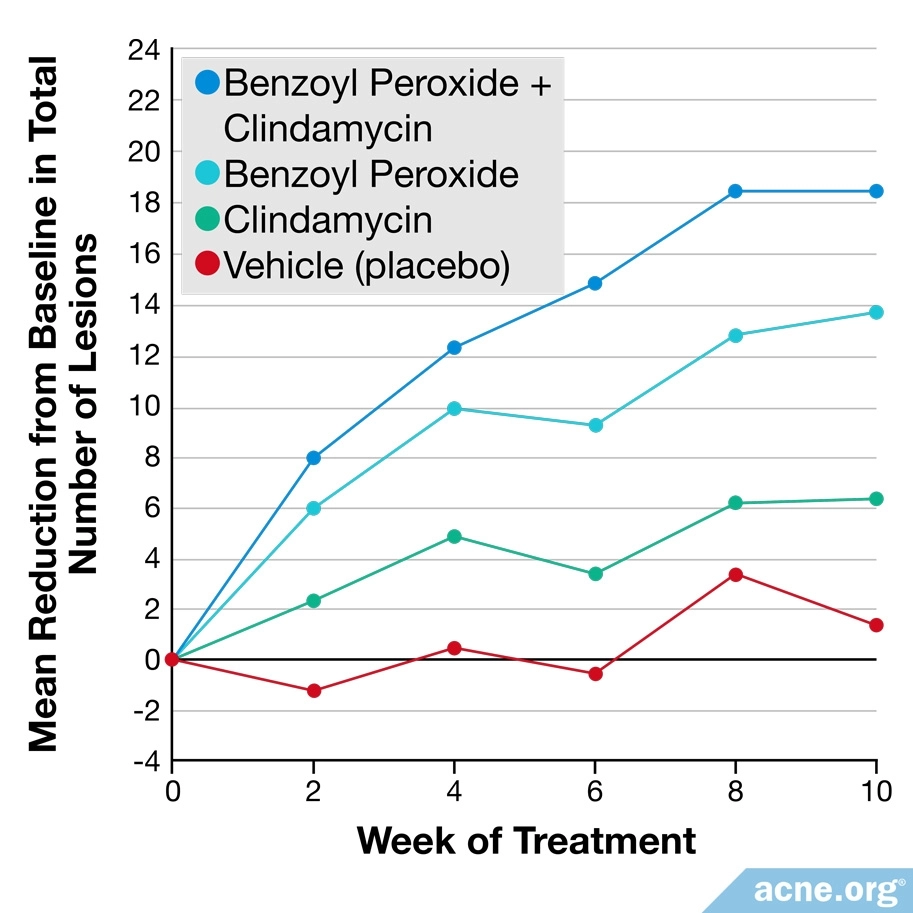
#4: Minocycline
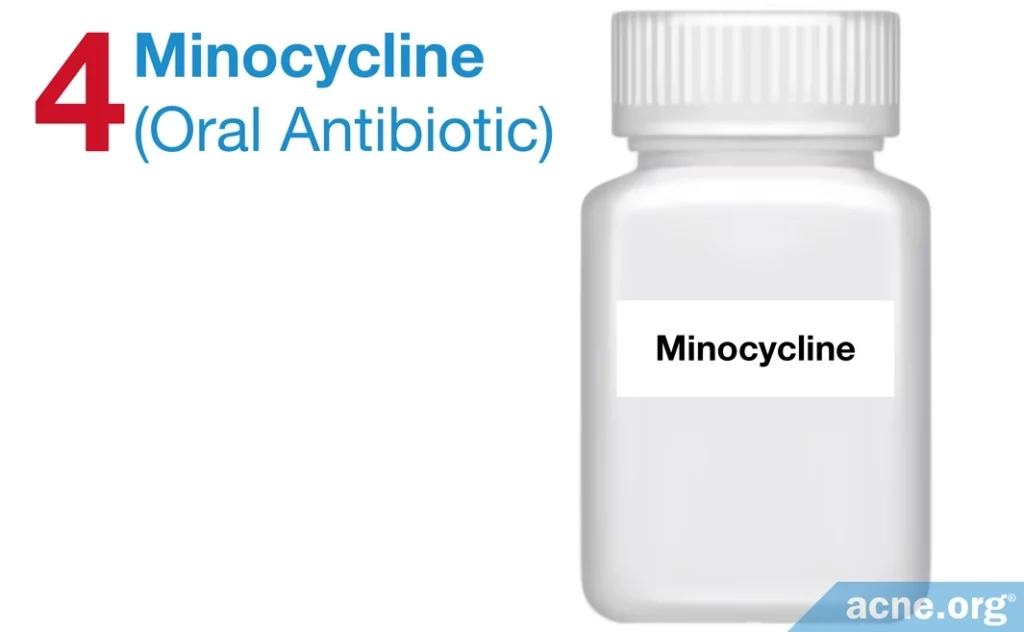
Minocycline is the fourth-most commonly prescribed acne medication. It is an oral antibiotic that belongs to the class of antibiotics known as tetracyclines, which are the most widely prescribed oral antibiotics for acne because of their effectiveness against acne bacteria and their anti-inflammatory effects. As with topical antibiotics, oral antibiotics should be used for a maximum of three months, and do not work for everyone. When they do work, they only provide moderate benefit, and can come with many side effects, particularly gastrointestinal discomfort.
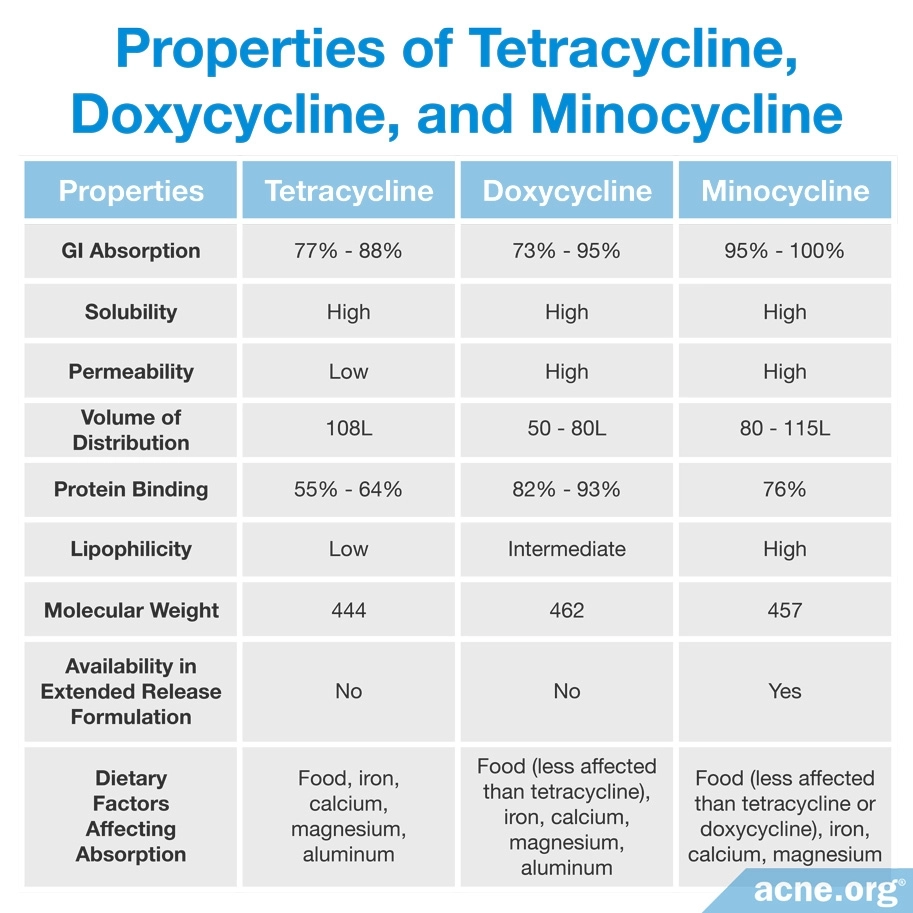
Other oral tetracycline antibiotics exist (such as doxycycline and tetracycline), but minocycline is prescribed more often because, as is discussed in the following 2011 article in The Journal of Clinical and Aesthetic Dermatology, it may accumulate more in the skin, providing for better acne-killing properties and lowered risk of creating resistant bacteria. In addition, it may be better absorbed in the gut and have less food interactions compared with other oral tetracyclines. On a downside, it comes with more side effects, so doctors often prescribe the extended-release form of minocycline to reduce these unwanted effects.
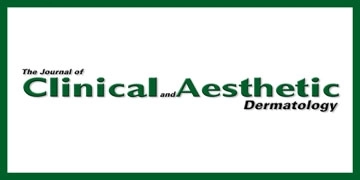
A 2011 article in The Journal of Clinical and Aesthetic Dermatology found that minocycline accumulated in skin tissue in significantly greater amounts than did other tetracyclines. It also noted that in a six-week study comparing minocycline to other tetracyclines, minocycline decreased acne bacterialevels 10 times more than did the other tetracyclines, the reduction in acne bacteria persisting three weeks after the course of treatment. These results may be due to minocycline’s enhanced ability to penetrate skin tissue, thereby reducing the development of resistant bacteria. The authors noted, “Minocycline treatment may have an advantage compared with tetracycline or doxycycline because enhanced tissue penetration may be accompanied by a lower incidence of emergence of resistant [acne bacteria] strains.”6
The same article described another study that tested antibiotic resistance in 73 strains of acne bacteria. Compared to other antibiotics, minocycline was the only one that effectively targeted all 73 strains. This result demonstrates that minocycline is effective against most antibiotic-resistant strains of acne bacteria, which increases its viability.6
Minocycline possesses other characteristics that make it better than other oral antibiotics:
- It is absorbed into the gastrointestinal tract better than other oral antibiotics, which increases the amount of medication available.
- It doesn’t interact with as many foods as other oral antibiotics.
Prescribing Practices Change Over Time
Prescribing practices for the top 10 most frequently prescribed acne medications have changed. A comparison of data from the National Ambulatory Medical Care Survey database for the date ranges, 1989 – 2009, 2007 – 2009, and 2005 – 2010, shows us several trends:
- There has been no change in the prescribing of tretinoin, which consistently has been the most frequently prescribed acne medication for at least 21 years.
- There has been a decline in the prescribing of benzoyl peroxide and clindamycin as single therapies but an increase in the prescribing of clindamycin/benzoyl peroxide in combination.
- Though topical and oral treatment both consistently have been among the top 10 most commonly prescribed medications, topical therapy still is prescribed more often than oral therapy.
- Prescribing of minocycline declined briefly from 2007 – 2009, yet consistently has remained one of the four most commonly prescribed medications.4
- In recent years, experts have been urging doctors to limit antibiotic prescriptions, including those for acne. Widespread use of antibiotics increases the chances of bacteria developing antibiotic resistance, which can ultimately result in a global health crisis when antibiotics stop working against bacterial infections altogether. In the United States, the Centers for Disease Control and Prevention (CDC) has begun a campaign to educate medical professionals about when it is appropriate to prescribe antibiotics. Both the CDC and the World Health Organization (WHO) also organize an annual Antibiotic Awareness Week to draw attention to the problem of excessive antibiotic use.7,8 Although doctors have been slow to adopt the new guidelines, we are likely to see a decline in antibiotic prescriptions for acne in the future.
References
- Zaenglein, A. et al. Guidelines of care for the management of acne vulgaris. Journal of the American Academy of Dermatology (2016). https://www.ncbi.nlm.nih.gov/pubmed/26897386
- Millikan, L. The rationale for using a topical retinoid for inflammatory acne. American Journal of Clinical Dermatology 4, 75 – 80 (2003). https://www.ncbi.nlm.nih.gov/pubmed/12553848
- Tan, X. et al. Factors associated with topical retinoid prescriptions for acne. Journal of Dermatological Treatment 25, 110 – 114 (2013). https://www.ncbi.nlm.nih.gov/pubmed/23802699
- Hoover, W. et al. Topical antibiotic monotherapy prescribing practices in acne vulgaris. Journal of Dermatological Treatment 25, 97 – 99 (2013). https://www.ncbi.nlm.nih.gov/pubmed/24171409
- Leyden, J. et al. Comparison of the efficacy and safety of a combination topical gel formulation of benzoyl peroxide and clindamycin with benzoyl peroxide, clindamycin and vehicle gel in the treatments of acne vulgaris. American Journal of Clinical Dermatology 2, 33 – 39 (2001). https://www.ncbi.nlm.nih.gov/pubmed/11702619
- Leyden, J. & Del Rosso, J. Oral antibiotic therapy for acne vulgaris: Pharmacokinetic and pharmacodynamic perspectives. The Journal of Clinical and Aesthetic Dermatology 4, 40 – 47 (2011). https://www.ncbi.nlm.nih.gov/pubmed/21386956
- Del Rosso, J. Q., Webster, G. F., Rosen, T. et al. Status report from the scientific panel on antibiotic use in dermatology of the American Acne and Rosacea Society: Part 1: Antibiotic prescribing patterns, sources of antibiotic exposure, antibiotic consumption and emergence of antibiotic resistance, impact of alterations in antibiotic prescribing, and clinical sequelae of antibiotic use. J Clin Aesthet Dermatol 9, 18‐24 (2016). https://www.ncbi.nlm.nih.gov/pmc/articles/PMC4898580/
- King, L. M., Fleming-Dutra, K. E. & Hicks, L. A. Advances in optimizing the prescription of antibiotics in outpatient settings. BMJ 363, k3047 (2018). https://www.ncbi.nlm.nih.gov/pmc/articles/PMC6511972/
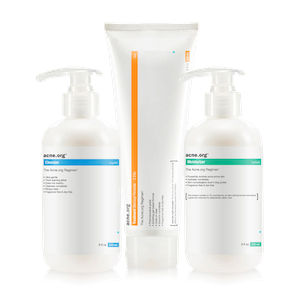 Acne.org Products
Acne.org Products